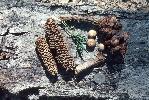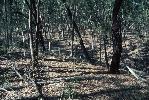Species profile—Macrozamia conferta
Classification
Plantae (plants) → Equisetopsida (land plants) → Zamiaceae → Macrozamia conferta

Go to Photo gallery
Species details
- Kingdom
- Plantae (plants)
- Class
- Equisetopsida (land plants)
- Family
- Zamiaceae
- Scientific name
- Macrozamia conferta D.L.Jones & P.I.Forst.
- WildNet taxon ID
- 6525
- Nature Conservation Act 1992 (NCA) status
- Vulnerable
- Environment Protection and Biodiversity Conservation Act 1999 (EPBC) status
- Vulnerable
- Conservation significant
- Yes
- Confidential
- Yes
- Endemicity
- Native
- Pest status
- Nil
- Short Notes
- Gymnosperm, two sheets plus carpological
- Description
- Macrozamia conferta has a branching underground stem 15-30cm in diameter, forming clumps of up to twelve crowns per plant. The sparse crown has 1-5 erect leaves 35-60 cm long, hairless except for light fawn wool at the base. Each leaf consists of 50-90 leaflets arranged along the spirally twisted (2-3 times) rhachis (central stalk). The shiny, dark green leaflets are moderately thick, 6-30cm long by 2-6mm wide. The tips of the leaflets are tapered to an asymmetrical point and the leaflet bases are slightly thickened and greenish to greenish-yellow, rarely reddish.
The plants reproduce by cones that are somewhat pineapple-like in appearance. Male and female cones develop on separate plants. Male cones are more or less cylindrical and 7-18 cm long by 2.5-4cm in diameter. Female cones are more or less ovoid (egg-shaped) 6-12cm long, and 3.5-6cm in diameter. Seeds are more or less ovoid (egg-shaped), 2-2.5cm long, 1.6-2cm in diameter and red when ripe.
Macrozamia conferta is allied to M. plurinervia but is readily distinguished by the much narrower, bright green shiny crowded leaflets, the smaller green cones, and much smaller seeds. (Jones & Forster 1994; Halford 1997; Hill 1998; DEWHA 2008) - Map
- View Map
- Habitat
- Macrozamia conferta occurs in undulating to hilly terrain at altitudes between 600-750m above sea level. It grows on flat areas or low ridges in ash-grey to white silty loam and on stony or skeletal grey-white soils on steep slopes. The species occurs in open eucalypt forest communities. (Halford 1997; DEWHA 2008)
- Behaviour
- Cross-pollination between individual Macrozamia conferta plants is effected by a species of Tranes weevil in an obligate mutualism. (Forster et al. 1994)
- Reproduction
- Macrozamia conferta has been recorded with mature cones in October and November. Ripe seeds have been recorded in February and March. Cones may not be produced annually when conditions are unfavourable. (Halford 1997)
- Predators
- All species of Macrozamia contain toxins which can cause debilitating symptoms or death if ingested in sufficient quantities by many mammals. (Halford 1997)
- Management documents
- Conservation and management of protected plants in trade in Queensland 1995-1998.
- Notes
- Contributors: Paul Forster, Ailsa Holland, Mellisa Mayhew 18/06/2009
- References
- Department of the Environment, Water, Heritage and the Arts (2008). Macrozamia conferta in Species Profile and Threats Database, Department of the Environment, Water, Heritage and the Arts, Canberra. Accessed 08/10/2008.
Forster, P.I., Machin, P., Mound, L. & Wilson, G. (1994). Insects associated with the reproductive structures of cycads in Queensland and north-east New South Wlaes, Australia. Biotropica 26: 217-222.
Halford, D (1997). Macrozamia conferta, in Species Management Manual. Department of Natural Resources, Brisbane.
Herbrecs (2008). Macrozamia conferta, in BriMapper version 2.12. Queensland Herbarium. Accessed 08/10/2008.
Hill, K.D. in McCarthy, P.M. (Ed) (1998). Flora of Australia 48: 654.
Jones, D.L. & Forster, P.I. (1994). Seven new species of Macrozamia section Parazamia (Miq.) Miq. (Zamiaceae section Parazamia) from Queensland. Austrobaileya 4(2): 271. - Profile author
- Paul Forster (18/06/2009)
Other resources
- Species Profile and Threats Database (SPRAT)
- The Australasian Virtual Herbarium (AVH)
- Atlas of Living Australia
Data source
This profile data is sourced from the QLD Wildlife Data API using the Get species by ID function used under CC-By 4.0.
https://apps.des.qld.gov.au/species/?op=getspeciesbyid&taxonid=6525.
This information is sourced from the WildNet database managed by the Queensland Department of Environment and Science.




